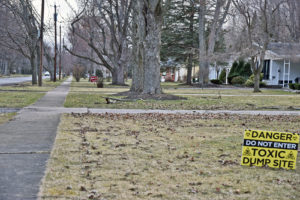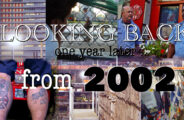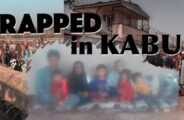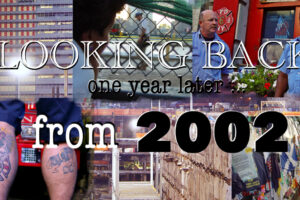Subdivision 650 feet from toxic landfill starts review process in Wheatfield
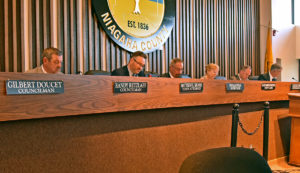
For years people have been complaining about the health of their families on the street that divides Wheatfield and North Tonawanda.
Nearby, along Niagara Falls Blvd. is a large, suspiciously vacant area of green space — the infamous Niagara Sanitation Landfill — where for decades following World War II area chemical companies trucked and dumped their toxic byproducts.
Homes were also built and and sold nearby without the new occupants knowing what lurked beneath the soil in that large, vacant area out back.
Deadly Love Canal toxic waste got shipped to the Wheatfield landfill just a few miles away when the 102nd Street site started remediation in 1979.
One family still living on Forbes Street today fled their Love Canal neighborhood only to find out their new home in Wheatfield’s semi-rural setting abutted another toxic landfill.
Other families have left — abandoning their homes — and have reported improving health.
Families on Forbes do not agree with the DEC’s recent declaration that chemicals from the landfill are not migrating to nearby residences based on soil tests, with the agency measuring soil only three inches deep.
So is the new 23-home subdivision 650 feet from one of the worst waste dumps in Niagara County a good idea?
“I can’t say yes or no because the zoning is in place,” said Wheatfield Supervisor Don MacSwan. “We have to wait until all the information comes in.”
It isn’t the first time the “Aubrey Way” project has come before the Wheatfield town board. Landowner Bob Weaver tried to build 23 homes there in 2015 but the motion to do what happened Monday night failed to get a second from any board member.
“Nothing has changed,” said one woman during the public comment period of Monday’s town board meeting. “Why would we go forward? Especially with all the Wilrose Court (flooding) problems.” (Some residents have even called for a town moratorium on construction until Wheatfield’s problems with unchecked over-development — creating suburban-like areas in Wheatfield’s traditionally rural environment — has been comprehensively addressed.)
“That was a mistake,” said MacSwan on Monday night before the vote. “At that time the board took no action. That was incorrect.”
“The board doesn’t have a choice,” said MacSwan. “Anybody has a right to go forward with the SEQR (State Environmental Quality Review) process.”
“He (Weaver) has had soil tests done, and that will all come forward during the environmental review process,” said MacSwan.
The motion to move the Aubrey Way subdivision forward to the SEQR process was made Monday by MacSwan and seconded by Curt Doktor, who were both elected in November after facing no competition in the primaries or the general election. Town board members Larry Helwig and Randy Retzlaff voted to approve while Gilbert Doucet was not present.
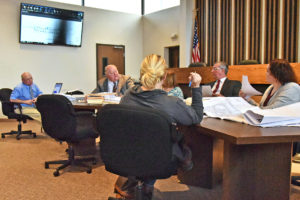
At last week’s planning board meeting — where the Aubrey Way subdivision was approved to be sent to the town board — residents of Forbes Street and Nash Road spoke out against the subdivision for health and quality-of-life reasons.
“I have two concerns on this,” said one speaker during the planning board’s non-compulsory brief comment period. “I live on Forbes Street. Everybody knows the situation I’m dealing with. We have two concerns: about drainage when they start doing this project if they are going to raise the grade. Are we going to end up with more water in our yard in Forbes?”
“Also about testing. I’ve heard they are testing for contaminants or whatever. I would like to know what they are testing for. Who’s going to be doing the testing?”
Planning Board Chairman Walt Garrow (above, second from left) responds: “Personally, right now the testing I’m aware of now is for radiation.”
In the audience somebody says “Radiation?”
“It’s a chemical dump,” says one woman in the audience.
Garrow: “There was a radiation study done.”
Another man asks, “Has the EPA given you guys the go-ahead that the land’s clean now?”
Garrow: “As we mentioned, from here we go to the environmental considerations. So we are going to be ending this consideration of design. And we are going to recommend to the town board that they would go to SEQR, which looks at environmental issues.”
Resident: “Who would be in charge of that since it’s a residential area. Will it be the EPA or the DEC?”
Garrow: “The SEQR process will be organized through the town board. And the town board would involve the agencies as needed. That was more than I was going to but … ”
“How far is that going to be away from the where they had the Love Canal waste that they had moved out? How far is the development going to be away from that site.
Tim Zuber (above, first from left) responds: “From what I can measure through the GIS system at the closet point it’s over 650 feet,” said Zuber, a project engineer for engineering firm Wendel.
Talking in the audience. “That’s not a big amount.”
“Are these reports going to be available?” asks another resident. “The environmental impact studies. Is that online where we can take a look?”
Garrow: “I think we can make that … “
He’s interrupted by someone on the planning board and says, “There is no environmental impact statement.”
“Will that be available to everybody?” the man asks.
“As we go through the SEQR process — if that is required — absolutely.”
“Well, we’d like to see it,” the resident says.
“There’s no defined testing yet.”
“What’s the timeline on that?” the man asks.
“It starts with tonight; with us giving the recommendation to the town. Then the town has to start the process. The process has a month initiation time but then it could go on after that. So I can’t really answer that.”
“But will it be public information? Will it be available?”
Zuber: “With the site plan, there will probably be another hearing with public participation.”
Woman in audience: “Can’t the planning board take into consideration not just drainage for this development during this plan, but what the the development’s effect will be townwide? Because in the past we’ve had problems. Nobody in that development is going to flood. But the problem is. We all know there’s drainage issues and that affects further down the line. And when you put that in there it might affect my house or some other house three miles down the road.”
Garrow: “It will be part of this board’s process of looking at hydrology along with our engineer. We will be looking at total hydrology impact.”
The chairman says, “But we have to go back to the agenda” before he sees another man waiting to speak.
“You’ve been patient and waiting … so … last one!”
“I own a lot just south of the right of way. You’re talking about putting in drainage and was wondering about the drainage at back of these lots. And specifically the back of the south side of your lot. Is that going to become more flooded and therefore wash out the rest of the neighborhood?”
Garrow: “That will be part of our consideration with the site plan when we get that back again. I am aware of the draining systems that in place should improve the situation instead of making it worse.”
Someone in the audience asks, “Where’s this water going to drain to?”
Bill: “I would like to invite all of you to come at any time to my land and just look at the water. Walk out to the back of my land and look at the water. I don’t care. Come and see it.”
Garrow: “We are going to be looking at that.”
After the planning board voted to move the SEQR process to the town board, residents gathered outside.
“It’s just disgusting,” said one resident.
“They need to test for dioxins, PCBs.”
Other Forbes Street residents have said testing needs to be performed in the houses and basements— not on three inches of topsoil that most likely has been replaced due to yearly flooding.
“Why would you want to buy next to a waste dump?” asked another resident.
“Two houses have sold recently,” said one woman. “And people are buying them and moving little kids in there. And they know there’s chemicals. They drive by the sign that says “Toxic” and then walk their baby by it.”
“It’s just sad,” said another resident.
“When they dug all that crap out of the back, it was letting like the dragon right out of his lair and it’s on the attack. Because it’s gotten worse since that all happened.”
